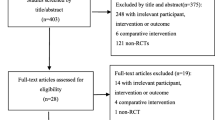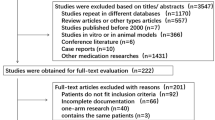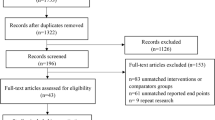Abstract
Background
Obesity accompanied by visceral fat accumulation is an essential disease background of non-alcoholic fatty liver disease (NAFLD). Obesity is a key factor and is also directly related to alterations in anthropometric measurements. It has been demonstrated that exercise intervention is the mainstay treatment for NAFLD patients. Therefore, this research investigates a literature review on anthropometric measurements and exercise interventions given to patients with NAFLD.
Objectives
To conduct a literature review on the effectiveness of exercise interventions over the anthropometric measurements among non-alcoholic fatty liver disease patients.
Methodology
Based on available clinical evidence, a literature review will be performed. We identified 21 randomized controlled trials (RCTs) that will be analyzed further.
Results
According to the results of the investigation, there was not much of a difference in the anthropometric changes that were found as a result of the various exercise regimens on NAFLD patients.
Conclusion
Even though there were significant changes in fat parameters such as lipid tests and other outcome measures, there were no immediate significant changes in anthropometric measurements as a consequence of the NAFLD exercise intervention.
Similar content being viewed by others
Introduction
The buildup of fat in the hepatocyte cells is the defining characteristic of non-alcoholic fatty liver disease. This characteristic occurs in the absence of any significant consumption of alcohol. It begins as basic steatosis, and then gradually advances to steatoheptatitis, and finally, in its later stages, it leads to cirrhosis (liver failure). Global prevalence, primarily in Western countries, is estimated to be between 20 and 30%, and there has been an uptick in reported cases among Indians [1].
Patients with type 2 diabetes were shown to experience significant changes in their body fat distribution, insulin sensitivity, and glycemic control when they participated in exercise training [2].
Dietary restriction, behavioral modifications, and modest weight loss are the primary components of the treatment plan that doctors propose for NAFLD patients. The incorporation of physical activity as a primary focus of treatment is an idea that is being considered for further development in the future. Exercise training has been shown to stimulate the muscle fiber and metabolism process; provided that the training is performed correctly, one can anticipate a reduction in the amount of adipose tissue [3].
Anthropometry is one of the inexpensive methods, easy to carry equipment, and non-invasive methods that are used all over the world to measure various aspects of the human body. The combination of an individual’s height and weight, sometimes known as the body mass index (BMI), is widely regarded as the most reliable evaluation tool for determining an adult's nutritional health. This method is not only cost-effective but also straightforward, possesses higher levels of precision, and is generally recognized. The body mass index (BMI) is a measure that is not only affordable and straightforward but also has demonstrated efficacy. The body mass index (BMI) is a non-invasive, convenient technique for assessing children's weight status and helping to identify them as either underweight, overweight, or obese within the population [4].
The prevalence of metabolic syndrome, in conjunction with an increase in NAFLD, has been observed to be on an upward trend. It is generally agreed that obesity is the single most important contributor to the development of NAFLD. There is a positive correlation between increases in body mass index (BMI) and waist-hip circumference (WC), which is another element in the advancement of hepatic abnormalities. Therefore, they are factors that contribute to the development of NAFLD [5].
Body mass index (BMI), which is calculated by adding their height and weight together, as well as their waist and hip circumferences, fat mass, lean mass, visceral adipose tissue, and subcutaneous adipose tissue, are all examples of anthropometric measurements.
Several randomized controlled trial (RCT) investigations on exercise intervention and changes in hepatic lipids and blood lipid parameters have been undertaken. Anthropometric alterations were also seen in those patients as part of baseline features, but not to a greater extent in those studies (Fig. 1).
As a result, this study attempts a literature analysis on anthropometric parameters modified by exercise intervention in the available data from 2013 to 2020. We discovered 21 RCTs and essential aspects were analyzed and detailed as follows (Fig. 1).
Anthropometry and aerobic-only intervention
The most important findings regarding anthropometry characteristics are shown in Table 1, which details the outcomes of aerobic exercise interventions [6].
Aerobic exercise alone was shown to be effective in lowering anthropometric parameters in a study conducted by Gholami et al. for a period of 1 year, which included three sessions per week of aerobic-only intervention. The researchers came to the conclusion that weight loss, body mass index, and visceral fat mass all demonstrated statistically significant reduction values (P < 0.05).
According to the findings of a study that was carried out by Zhang et al., vigorous aerobic exercise led to a substantial reduction in body weight and waist-hip ratio, body fat mass, and other fat parameters, while vigorous to moderate aerobic exercise led to a significant reduction in fat mass when compared with the control group [7].
Oh s et al. reported that aerobic training in the form of HIAT and MICT might enhance hepatic fat more considerably, but it did not alter anthropometric parameters like BMI and waist-hip ratio very well when training was administered for 12 weeks [12].
Cheng et al. conducted research on the effects of aerobic exercise on patients with NAFLD and discovered that anthropometric parameters, such as body mass index (BMI), fat mass, visceral adipose tissue, and subcutaneous adipose tissue, did not improve significantly despite the fact that exercise training was administered for a period of 9 months [9].
Aerobic exercise performed for 30–40 min per session on an ergometer for a period of 12 weeks resulted in greater improvements in anthropometric factors such as body mass index (BMI), weight and fat mass, and body fat percentage; however, there were no improvements found in lean body mass by Kate Hallsworth et al. [10].
It was observed by Calvin Kruger and colleagues that there was not a significant change in anthropometric features when aerobic training was performed at home for a period of 8 weeks, primarily on an ergometer as a method of training [11].
After conducting research on the benefits of simple walking aerobic exercise for a period of 12 weeks, Oh et al. and his colleagues found that both body weight and BMI improved dramatically, along with body adiposity parameters [16].
According to Pretham Nath's research, low-intensity aerobic activity alone can be successful in improving body weight and BMI factors as well as waist-hip ratio; however, only moderate-intensity aerobic intensity, such as brisk walking and jogging, can improve hepatic factors [13].
Aerobic training in the form of high-intensity interval training and moderate-intensity continuous training was shown to be equally efficient in improving anthropometric parameters when carried out for a period of 8 weeks by Abdel Bassett et al. [16].
NAFLD patients showed significant changes in their body mass index (BMI) after participating in high-intensity interval training consisting of cycle ergometer workouts for a period of 8 weeks, as discovered by Abdelbasset et al. [14].
Anthropometry and resistance only intervention
After 3 months of resistance training, Zelber Sagi et al. discovered that the baseline parameters did not alter significantly as a result of the intervention. The body mass index (BMI), the waist circumference (WC), and the fat index parameter did not yield the expected change [17].
Kriti Damor et al. found that progressive resistance exercise, when done for a period of 12 weeks, had a significant decrease in waist, hip, and mid-thigh circumferences, as well as in skinfold thickness values; however, there was no significant change in weight or BMI; this indicates that muscle mass has increased, leading to a subsequent reduction in fat mass as a result of the intervention [18].
When compared to the control group, simple resistance training such as push-ups and squats for a period of 12 weeks was shown to significantly improve fat-free mass and muscle mass; however, it was unable to significantly alter body weight or body mass index [19].
When performed for a period of 24 weeks Atsushi Takashi and colleagues discovered that resistance training using one’s own body weight did not alter anthropometric parameters such as one’s body mass index (BMI), weight, or fat mass parameter [20].
Table 2 outlines the significant findings that were made regarding anthropometry attributes as a direct result of resistance’s treatments.
Anthropometry and combined aerobic and resistance intervention
When resistance training and aerobic exercise were combined for a period of 4 months, Bacchi et al. discovered that the body mass index (BMI), total body fat mass, and visceral adipose tissue all decreased significantly when compared to other metrics [2].
When both combined aerobic and resistance exercise interventions were performed, Shamsoddini et al. came to the conclusion that improvements in weight, BMI, and waist-hip circumference were found to be more significant in the resistance group than in the aerobic group [21]. This was the case despite the fact that there was no improvement in subcutaneous adipose tissue levels.
When comparing the effects of aerobic exercise in the form of stationary cycling and resistance training in the form of gym weights for a period of 12 weeks, Brouwers et al. found that there was no significant difference in the parameters of body weight, BMI, and waist-hip circumference. Skeletal muscle was improved by exercise training, but there was no change in the amount of fat tissue [22].
After 16 weeks of combined exercise training, Shoajee Moradie et al. came to the conclusion that aerobic exercise, which consisted of mainly predominantly outdoor activity and simple resistance exercise, resulted in significant improvements in body weight and BMI, with the latter reducing by 3.6% overall, in addition to improvements in body fat parameters [23].
Improvements were identified in visceral adipose tissue and lean body mass, but not in other parameters such as BMI or subcutaneous adipose tissue when combined exercise training aerobic and resistance were given for 12 weeks [24]. Houghton et al. said that these improvements were obtained when combined exercise training of aerobic and resistance was given.
Mohameed Ebrahim and colleagues conducted a study on the effects of combining aerobic exercise with resistance training. They found that the subjects' body weight and BMI dropped dramatically after 8 weeks of exercise, and they also came to the conclusion that aerobic exercise is more effective than resistance training [3].
The essential components of combination interventions are detailed in Table 3, which also includes information about anthropometric characteristics.
Conclusion
This literature review examined the effects of several exercise interventions and training approaches on NAFLD patients. Only a few trials showed statistically significant improvements in BMI, waist-hip circumference, and other noninvasive lipid markers. Most anthropometric indicators did not improve statistically, although hepatic and blood lipid measures did. Therefore, exercise intervention takes longer to improve anthropometric factors, and further research on high-intensity protocols for NAFLD patients should focus on both hepatic fat parameters and anthropometric factors.
Availability of data and materials
Data openly available in a public repository that issues datasets with DOIs.
Abbreviations
- NAFLD:
-
Non-alcoholic fatty liver disease
- BMI:
-
Body mass index
- RCT’s:
-
Randomized controlled trial
- WC:
-
Waist circumference
- HIAT:
-
High-intensity aerobic training
- MICT:
-
Moderate intensity continuous training
References
Khaoshbaten M, Gholami N, Sokhtehzari S, Monazami AH, Nejad MR. The effect of aerobic exercise on serum level of liver enzymes and liver echogenicity in patients with non-alcoholic fatty liver disease. Gastroenterol Hepatol Bed Bench. 2013;6(SUPPL1):S211.
Bacchi E, Negri C, Targher G, Faccioli N, Lanza M, Zoppini G, et al. Both resistance training and aerobic training reduce hepatic fat content in type 2 diabetic subjects with nonalcoholic fatty liver disease (the RAED2 randomized trial). Hepatology. 2013;58(4):1287–95.
Ghamarchehreh ME, Shamsoddini A, Alavian SM. Investigating the impact of eight weeks of aerobic and resistance training on blood lipid profile in elderly with non-alcoholic fatty liver disease: a randomized clinical trial. Gastroenterol Hepatol Bed to Bench. 2019;12(3):190–6.
Karim A, Qaisar R. Anthropometric measurements of school-going-girls of the Punjab. Pakistan BMC Pediatr. 2020;20(1):1–13.
Tahir F, Majid Z, Majid B, Ahmed J, Zaman A, Tariq M, et al. Anthropometric Measurements and Lifestyle Characteristics of Individuals with Non-alcoholic Fatty Liver Disease. Cureus. 2020;12(2):1–10.
Khaoshbaten M, Gholami N, Sokhtehzari S, Monazami AH, Nejad MR, Bacchi E, et al. The effect of aerobic exercise on serum level of liver enzymes and liver echogenicity in patients with non-alcoholic fatty liver disease. Hepatology. 2013;98(7):6–8.
Zhang HJ, He J, Pan LL, Ma ZM, Han CK, Chen CS, et al. Effects of moderate and vigorous exercise on nonalcoholic fatty liver disease: a randomized clinical trial. JAMA Intern Med. 2016;176(8):1074–82.
Oh S, Shida T, Yamagishi K, Tanaka K, So R, Tsujimoto T, Shoda J. Moderate to vigorous physical activity volume is an important factor for managing nonalcoholic fatty liver disease: a retrospective study. Hepatology. 2015;61(4):1205-15.
Cheng S, Ge J, Zhao C, Le S, Yang Y, Ke D, et al. Effect of aerobic exercise and diet on liver fat in pre-diabetic patients with non-alcoholic-fatty-liver-disease: a randomized controlled trial. Sci Rep. 2017;7(1):1–11.
Hallsworth K, Thoma C, Hollingsworth KG, Cassidy S, Anstee QM, Day CP, et al. Modified high-intensity interval training reduces liver fat and improves cardiac function in non-alcoholic fatty liver disease: a randomized controlled trial. Clin Sci. 2015;129(12):1097–105.
Kruger C, McNeely ML, Bailey RJ, Yavari M, Abraldes JG, Carbonneau M, et al. Home exercise training improves exercise capacity in cirrhosis patients: role of exercise adherence. Sci Rep. 2018;8(1):1–10.
Oh S, So R, Shida T, Matsuo T, Kim B, Akiyama K, et al. High-intensity aerobic exercise improves both hepatic fat content and stiffness in sedentary obese men with nonalcoholic fatty liver disease. Sci Rep. 2017;7(February):1–12.
Nath P, Panigrahi MK, Sahu MK, Narayan J, Sahoo RK, Patra AA, et al. Effect of exercise on nafld and its risk factors: Comparison of moderate versus low intensity exercise. J Clin Transl Hepatol. 2020;8(2):120–6.
Abdelbasset WK, Tantawy SA, Kamel DM, Alqahtani BA, Soliman GS. A randomized controlled trial on the effectiveness of 8-week high-intensity interval exercise on intrahepatic triglycerides, visceral lipids, and healthrelated quality of life in diabetic obese patients with nonalcoholic fatty liver disease. Medicine. 2019;98(12).
Abdelbasset WK, Tantawy SA, Kamel DM, Alqahtani BA, Elnegamy TE, Soliman GS, et al. Effects of high-intensity interval and moderate-intensity continuous aerobic exercise on diabetic obese patients with nonalcoholic fatty liver disease: a comparative randomized controlled trial. Medicine (Baltimore). 2020;99(10):e19471.
Laube R, Wang H, Park L, Heyman JK, Vidot H, Majumdar A, et al. High-intensity aerobic exercise improves both hepatic fat content and stiffness in sedentary obese men with nonalcoholic fatty liver disease. Liver Transplant [Internet]. 2018;13(3):1–12. Available from: BMC Pulmonary Medicine.
Zelber-Sagi S, Buch A, Yeshua H, Vaisman N, Webb M, Harari G, et al. Effect of resistance training on non-alcoholic fatty-liver disease a randomized-clinical trial. World J Gastroenterol. 2014;20(15):4382–92.
Damor K. Effect of progressive resistance exercise training on hepatic fat in Asian Indians with non-alcoholic fatty liver disease. Br J Med Med Res. 2013;4(1):114–24.
Takahashi A, Abe K, Usami K, Imaizumi H, Hayashi M, Okai K, et al. Simple resistance exercise helps patients with non-alcoholic fatty liver disease. Int J Sports Med. 2015;36(10):848–52.
Sciences C, Takahashi A, Imaizumi H, Hayashi M, Abe K, Usami K, et al. Simple resistance exercise for 24 weeks decreases alanine ami- notransferase levels in patients with non-alcoholic fatty liver disease. 2017.
Shamsoddini A, Sobhani V, Ghamar Chehreh ME, Alavian SM, Zaree A. Effect of aerobic and resistance exercise training on liver enzymes and hepatic fat in Iranian men with Nonalcoholic fatty liver disease. Hepat Mon. 2015;15(10):114–24.
Brouwers B, Schrauwen-Hinderling VB, Jelenik T, Gemmink A, Sparks LM, Havekes B, et al. Exercise training reduces intrahepatic lipid content in people with and people without nonalcoholic fatty liver. Am J Physiol - Endocrinol Metab. 2018;314(2):E165–73.
Shojaee-Moradie F, Cuthbertson DJ, Barrett M, Jackson NC, Herring R, Thomas EL, et al. Exercise training reduces liver fat and increases rates of VLDL clearance but not VLDL production in NAFLD. J Clin Endocrinol Metab. 2016;101(11):4219–28.
Houghton D, Thoma C, Hallsworth K, Cassidy S, Hardy T, Burt AD, et al. Clin Gastroenterol Hepatol [Internet]. 2017;15(1):96-102.e3. Available from: https://doi.org/10.1016/j.cgh.2016.07.031.
Acknowledgements
I thank Dr. Chandramohan for helping me out throughout this study by reviewing and helping me in this completion.
Funding
NA.
Author information
Authors and Affiliations
Contributions
Both primary/corresponding author and secondary authors have equal contributions in the article. Both authors read and approved the final manuscript.
Corresponding author
Ethics declarations
Ethics approval and consent to participate
NA.
Consent for publication
Yes. We give consent for the publication of this study.
Competing interests
The authors declare that they have no competing interests.
Additional information
Publisher’s Note
Springer Nature remains neutral with regard to jurisdictional claims in published maps and institutional affiliations.
Rights and permissions
Open Access This article is licensed under a Creative Commons Attribution 4.0 International License, which permits use, sharing, adaptation, distribution and reproduction in any medium or format, as long as you give appropriate credit to the original author(s) and the source, provide a link to the Creative Commons licence, and indicate if changes were made. The images or other third party material in this article are included in the article's Creative Commons licence, unless indicated otherwise in a credit line to the material. If material is not included in the article's Creative Commons licence and your intended use is not permitted by statutory regulation or exceeds the permitted use, you will need to obtain permission directly from the copyright holder. To view a copy of this licence, visit http://creativecommons.org/licenses/by/4.0/.
About this article
Cite this article
R., S., R., C. “Anthropometric measurements and exercise interventions in non-alcoholic fatty liver disease patients”: a literature review. Bull Fac Phys Ther 29, 3 (2024). https://doi.org/10.1186/s43161-023-00164-5
Received:
Accepted:
Published:
DOI: https://doi.org/10.1186/s43161-023-00164-5





